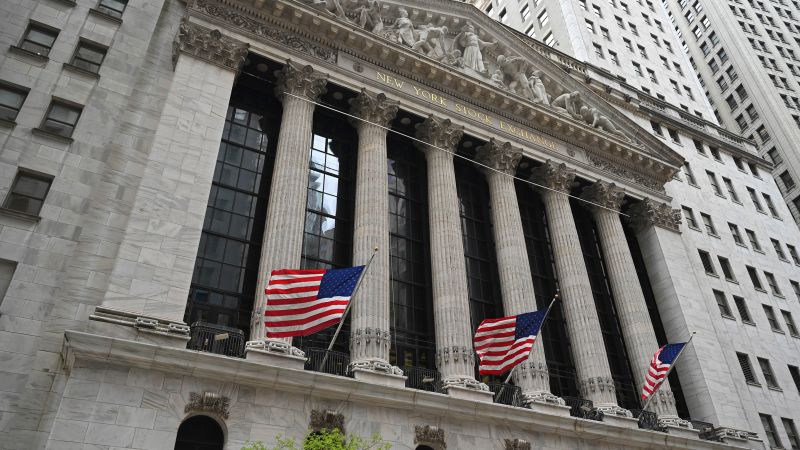A version of this story first appeared in CNN Business’ Before the Bell newsletter. Not a subscriber? You can sign up right here. You can listen to an audio version of the newsletter by clicking the same link.
New York
CNN
—
Stocks saw a comeback on Friday after four consecutive days of declines. But there are several key signs that show the market is far from shedding its worries.
The Dow surged about 547 points on Friday, marking its biggest one-day gain since early January. The S&P 500 rose 1.8% and the Nasdaq Composite gained 2.3%.
Still, the Dow and S&P 500 fell for the week, and the Nasdaq just barely eked out a gain. The major indexes saw steep sell-offs earlier in the week after First Republic’s collapse, its subsequent sale to JPMorgan Chase and reports that other regional banks were exploring strategic options spurred fears about the banking sector’s stability.
Investors say Friday’s move was a short-term reversal, and not indicative of long-lasting optimism. In other words, Wall Street still has concerns about the banking sector’s health, the Federal Reserve’s interest rate trajectory and the possibility of recession.
“The larger themes that we’ve been thinking about are still very much in place,” said David Keller, chief market strategist at StockCharts.com.
That was evident in several aspects of the market.
Defensive sectors: The S&P 500’s health, utilities and information technology sectors rose for the week and outperformed the broad-based index. That suggests investors are positioning themselves defensively to weather potential market turbulence ahead.
Health and utility stocks tend to perform well during recessions, since consumers prioritize paying for necessities like electricity and health care over discretionary purchases when their budgets are tight.
While information technology is not a traditionally defensive sector, its gains were driven by mega-cap tech stocks like Apple that have been popular safety picks for investors this year.
Oil: Crude prices fell for the third straight week, as turmoil in the banking sector and the Federal Reserve’s latest interest rate hike strengthened fears that the economy is headed for a downturn.
West Texas Intermediate crude futures, the US benchmark for oil, last week fell briefly below $70 a barrel for the first time since late March. Crude prices this year have also fallen well below record highs from 2022, when Russia’s invasion of Ukraine sent prices soaring above $100 a barrel.
Oil prices also saw a flash-crash early Thursday, falling briefly to about $63 a barrel, indicating that Wall Street is fearful about how a potential recession could stymie oil demand.
VIX: The VIX, known as Wall Street’s fear gauge, rose roughly 9% this week after falling for six straight weeks.
The April Consumer Price Index and Producer Price Index are on deck for next week. Both are key inflation prints that could help determine the Fed’s next course of action in its battle against inflation.
In March, annual CPI plunged to its lowest rate since May 2021, while the PPI saw a dramatic cooldown. The Personal Consumption Expenditures price index, the Fed’s favorite inflation gauge, also eased.
But a strong April jobs report has renewed concerns that the economy is still too hot. The economy added 253,000 jobs in April, according to the Bureau of Labor Statistics. Unemployment fell to 3.4%, matching a 53-year low reached in January. Economists had expected 180,000 jobs to be added and a 3.6% unemployment rate, according to Refinitiv.
The unexpected jump in job gains after cooling economic data in recent weeks suggests that the Federal Reserve could have more room to tighten the economy. If next week’s inflation data further supports the notion that the economy is hot, that could increase the likelihood that the central bank keeps interest rates higher for longer.
“Even with the improvements that we’ve seen over the past few months in year-over-year inflation data, the level of overall inflation remains too high on an absolute basis,” said Sam Millette, fixed income strategist at Commonwealth Financial Network.
While economists and investors believe the Fed could pause interest rates at its next meeting in June, some are concerned that the central bank’s willingness to raise rates even after three bank failures suggests that it could continue inflicting pain on the economy. The Fed on Wednesday raised interest rates by a quarter point and opened the door to a pause later this year.
“What it really says is that the economy is not in trouble, can easily handle slightly higher rates, and that the regional banking indigestion of the higher rates is not a reason to stop the fight to slow inflation,” Louis Navellier, chief investment officer at Navellier & Associates, wrote in a note Friday.
Monday: March wholesale inventories and first-quarter Fed Senior Loan Officer Opinion Survey.
Tuesday: Earnings report from Airbnb (ABNB).
Wednesday: April Consumer Price Index and earnings report from Disney (DIS).
Thursday: April Producer Price Index, mortgage rates and jobless claims.
Friday: University of Michigan consumer sentiment and inflation expectations for May.
Sumber: www.cnn.com






